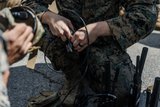As lead technology integrator for AEWE, Raytheon demonstrates high-bandwidth wireless communications and network interoperability
As the lead technology integrator for the recent US Army Training and Doctrine Command's Army Expeditionary Warrior Experiment (AEWE), Raytheon Company successfully connected more than 25 technologies from more than 20 different companies and agencies into a common network.
This was the first time the Army contracted this role to an industry partner. The key enabler for the common network was Raytheon's Mobile Ad-Hoc Interoperable Network GATEway (MAINGATE).
In AEWE, MAINGATE served as the backbone network, providing radio interoperability via the network, not the radio. The result was seamless communications, data and video sharing among mounted and dismounted forces using different radios or networks.
Specifically, the network was composed of fixed ground locations, tactical vehicles, airborne relays, and individually networked soldiers. It also connected communication devices, command and control applications, and sensor platforms. MAINGATE linked unattended ground systems, unmanned ground vehicles, and unmanned aircraft systems.
"This was the first time the US Army employed a mobile network, successfully interconnecting many disparate radio sub-networks over a large area to share data seamlessly in simulated missions," said Brian McKeon, Raytheon Network Centric Systems vice president of Integrated Communications Systems. "This successful demonstration reinforces MAINGATE's potential to achieve interoperability among the diverse radios used by coalition forces," McKeon added. "Never before has so much bandwidth been available to the warfighter at these echelons."
MAINGATE, which was designed in partnership with the Defense Advanced Research Projects Agency, has the tactical network capacity to provide four simultaneous video streams; image transfers; voice bridging; and complete situational awareness and command and control down to the squad level.
"DARPA had the vision to foresee how this technology could transform the modern battlefield," said McKeon.
AEWE is the Army's premier live, soldier-focused, network-enabled venue for aggressive experimentation of emerging and existing technologies. More than 150 soldiers participated in 14 missions through live operations and virtual simulations. AEWE is a live, operational experiment that provides insights to evaluate the mission effectiveness of technologies and concepts for soldiers and small units.
Source: Raytheon
More from Digital Battlespace
-
![Chess Dynamics successfully demonstrates Vision4ce AI-driven tracker]()
Chess Dynamics successfully demonstrates Vision4ce AI-driven tracker
The Vision4ce Deep Embedded Feature Tracking (DEFT) technology software is designed to process video and images by blending traditional computer vision with artificial intelligence (AI) algorithms to present actionable information from complex environments.
-
![Wave Relay devices cleared for security use on commercial systems in industry trend]()
Wave Relay devices cleared for security use on commercial systems in industry trend
Persistent Systems has been cleared by National Security Agency (NSA) to transmit sensitive data on commercial networks. The devices are added to the NSA’s Commercial Solutions for Classified (CSfC) component list which also includes other companies’ products providing the same security.
-
![UK teases cyber spending boost in Strategic Defence Review ahead of “imminent” release]()
UK teases cyber spending boost in Strategic Defence Review ahead of “imminent” release
The release of the UK’s Strategic Defence Review (SDR) has been long promised as mid-year. It is possible it could be as early as 2 June although the UK Ministry of Defence (MoD) continues to play its cards close to its chest.
-
![Intelsat emphasises SATCOM resilience for SOF in contested domains (video)]()
Intelsat emphasises SATCOM resilience for SOF in contested domains (video)
Intelsat outlines how its multi-orbit SATCOM architecture is enhancing connectivity and resilience for special operations forces operating in degraded and contested environments.
-
![US Space Force’s next-generation missile warning system moves forward with $500 million in new contracts]()
US Space Force’s next-generation missile warning system moves forward with $500 million in new contracts
Next-Generation Overhead Persistent Infrared (Next-Gen OPIR) satellites are intended to provide early warning of missile launches from any location worldwide and new ground stations will result in expanded coverage of critical missile warning.























